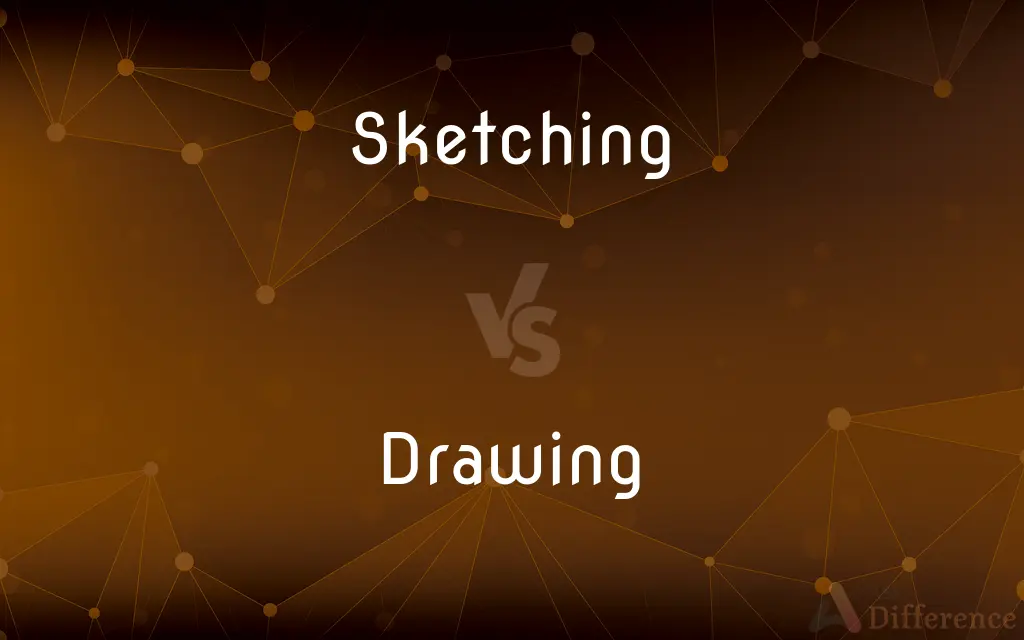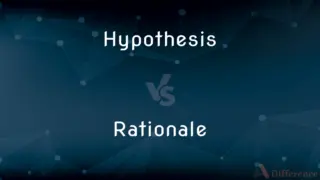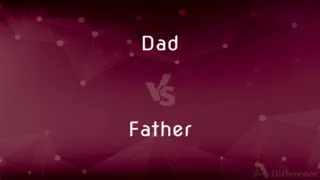Sketching vs. Drawing — What's the Difference?
By Fiza Rafique & Maham Liaqat — Updated on March 31, 2024
Sketching involves quick, freehand illustrations capturing the essence of a subject, while drawing is a detailed, precise art form focusing on accuracy and finish.

Difference Between Sketching and Drawing
Table of Contents
ADVERTISEMENT
Key Differences
Sketching is characterized by its spontaneity and fluidity, often serving as a preliminary stage where artists capture basic shapes and compositions. It's a way to visually brainstorm ideas or concepts without focusing on details. Drawing, on the other hand, is a more deliberate process, where artists invest time in refining their work, paying close attention to detail, texture, and shading to create a polished piece.
The tools and materials used in sketching are typically light and portable, such as pencils, pens, and sketchbooks, facilitating quick and easy creation. In contrast, drawing may involve a wider range of materials, including pencils, pens, ink, charcoal, and various types of paper, allowing for more depth, contrast, and detail.
Sketches are often left as unfinished works, capturing a moment, feeling, or idea in a raw form. They can be expressive and abstract, valuing the energy and movement of the artist's hand. Drawings, however, are usually completed pieces, showcasing the artist's skill in rendering subjects with precision and realism, or stylization in some cases.
While sketching is accessible and can be done by anyone at any skill level, drawing requires more practice and skill to master the techniques needed for detailed and accurate representations. Sketching can be seen as a foundational practice that can improve drawing skills, helping artists understand form, perspective, and composition in a more instinctive way.
Comparison Chart
Definition
Quick, informal illustrations focusing on basic shapes
Detailed, precise art form focusing on accuracy and finish
ADVERTISEMENT
Purpose
Capture the essence, brainstorm ideas
Create a refined, finished piece
Materials
Pencils, pens, sketchbooks
Pencils, ink, charcoal, various papers
Characteristics
Spontaneous, fluid, unfinished
Deliberate, detailed, completed
Skill Level
Accessible to all skill levels
Requires practice and skill for mastery
Compare with Definitions
Sketching
Quick illustrations capturing basic forms and ideas.
The artist began with a sketch to outline the composition.
Drawing
Detailed art focusing on precision and finish.
The drawing of the old oak was striking in its detail.
Sketching
Emphasizes spontaneity and movement.
Her sketches conveyed the movement of the dancers beautifully.
Drawing
Results in a completed, polished piece.
The finished drawing was a testament to her skill.
Sketching
Can be abstract or expressive.
The abstract sketches captured the essence of his emotions.
Drawing
Requires mastery of techniques.
Mastering drawing techniques took years of practice.
Sketching
Accessible and can be done anywhere.
She enjoyed sketching in cafes, capturing fleeting moments.
Drawing
Involves careful attention to detail and texture.
He spent hours on the texture of the fabric in his drawing.
Sketching
Often used as a preparatory stage.
Sketching the landscape helped him plan the painting.
Drawing
Often more time-consuming than sketching.
Completing the detailed drawing of the cityscape took weeks.
Sketching
A hasty or undetailed drawing or painting often made as a preliminary study.
Drawing
Drawing is a form of visual art in which an artist uses instruments to mark paper or other two-dimensional surface. Drawing instruments include graphite pencils, pen and ink, various kinds of paints, inked brushes, colored pencils, crayons, charcoal, chalk, pastels, erasers, markers, styluses, and metals (such as silverpoint).
Sketching
A brief general account or presentation; an outline.
Drawing
The act or an instance of drawing.
Sketching
A brief, light, or informal literary composition, such as an essay or a short story.
Drawing
The art of representing objects or forms on a surface chiefly by means of lines.
Sketching
(Music) A brief composition, especially for the piano.
Drawing
A work produced by this art.
Sketching
A short, often satirical scene or play in a revue or variety show; a skit.
Drawing
Present participle of draw
Sketching
(Informal) An amusing person.
Drawing
A picture, likeness, diagram or representation, usually drawn on paper.
Sketching
To make a sketch of; outline.
Drawing
The act of producing such a picture.
Sketching
To make a sketch.
Drawing
Such acts practiced as a graphic art form.
Sketching
Present participle of sketch
Drawing
The process of drawing or pulling something.
Proverb: An official is great in his office as a well is rich in drawings of water.
Sketching
Something drawn briefly and basically; a sketch.
A collection of Chinese sketchings
Drawing
An act or event in which the outcome (e.g., designating a winner) is selected by chance in the form of a blind draw, notably of lots; especially such a contest in which a winning name or number is selected randomly by removing (or drawing) it from a container, popularly a hat.
Drawing
A small portion of tea for steeping.
Drawing
The act of pulling, or attracting.
Drawing
The act or the art of representing any object by means of lines and shades; especially, such a representation when in one color, or in tints used not to represent the colors of natural objects, but for effect only, and produced with hard material such as pencil, chalk, etc.; delineation; also, the figure or representation drawn.
Drawing
The process of stretching or spreading metals as by hammering, or, as in forming wire from rods or tubes and cups from sheet metal, by pulling them through dies.
Drawing
The process of pulling out and elongating the sliver from the carding machine, by revolving rollers, to prepare it for spinning.
Drawing
The distribution of prizes and blanks in a lottery.
Drawing
An illustration that is drawn by hand and published in a book or magazine;
It is shown by the drawing in Fig. 7
Drawing
A representation of forms or objects on a surface by means of lines;
Drawings of abstract forms
He did complicated pen-and-ink drawings like medieval miniatures
Drawing
The creation of artistic drawings;
He learned drawing from his father
Drawing
Players buy (or are given) chances and prizes are distributed according to the drawing of lots
Drawing
Act of getting or draining something such as electricity or a liquid from a source;
The drawing of water from the well
Drawing
The act of moving a load by drawing or pulling
Common Curiosities
What materials are commonly used for sketching?
Pencils, pens, and sketchbooks are popular for their portability and ease of use.
What is drawing?
Drawing is a detailed art form focusing on precision, texture, and finish to create refined pieces.
Is digital sketching considered sketching?
Yes, digital sketching with tablets and styluses employs the same principles as traditional sketching.
What is sketching?
Sketching is creating quick, informal illustrations to capture basic forms or brainstorm ideas.
What is the main difference between sketching and drawing?
The main difference lies in the level of detail and the intent behind the creation, with sketching being more about capturing the essence quickly and drawing focusing on a detailed finish.
Can sketching improve drawing skills?
Yes, sketching can enhance understanding of form and composition, beneficial for detailed drawing.
Can anyone learn to draw or sketch?
Yes, with practice and dedication, anyone can develop their skills in both drawing and sketching.
How do artists use drawing in their work?
Artists use drawing to create detailed, polished artworks that showcase their technical skills.
Can sketches evolve into finished drawings?
Absolutely, sketches often serve as the conceptual foundation for detailed drawings, allowing artists to refine and develop their initial ideas into completed works.
What role does shading play in drawing?
Shading adds depth, dimension, and texture to a drawing, enhancing its realism or conveying a particular mood or atmosphere.
Are sketches always preliminary?
Often, but sketches can also stand alone as finished artworks, depending on the artist's intent.
Why is sketching considered important in art education?
Sketching is valued for its ability to quickly convey ideas and compositions, making it a fundamental skill in art education for improving observation and artistic expression.
Do professionals use sketching in their workflow?
Yes, many professionals, including architects, designers, and artists, use sketching as a crucial part of their creative process.
How does the choice of paper affect drawing?
The texture, weight, and color of paper can significantly affect the appearance and feel of a drawing, influencing both the medium's behavior and the final outcome.
How do artists choose between sketching and drawing for a project?
The choice depends on the project's goals, with sketching used for brainstorming and capturing quick ideas, and drawing for creating detailed, finished artwork.
Share Your Discovery

Previous Comparison
Hypothesis vs. Rationale
Next Comparison
Dad vs. FatherAuthor Spotlight
Written by
Fiza RafiqueFiza Rafique is a skilled content writer at AskDifference.com, where she meticulously refines and enhances written pieces. Drawing from her vast editorial expertise, Fiza ensures clarity, accuracy, and precision in every article. Passionate about language, she continually seeks to elevate the quality of content for readers worldwide.
Co-written by
Maham Liaqat













































